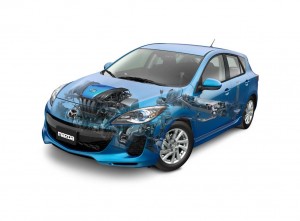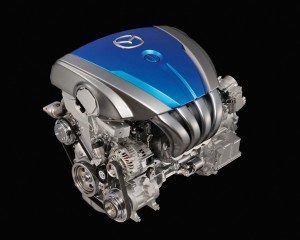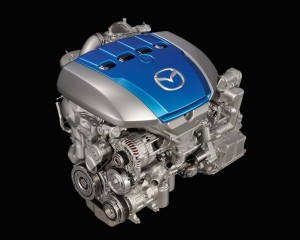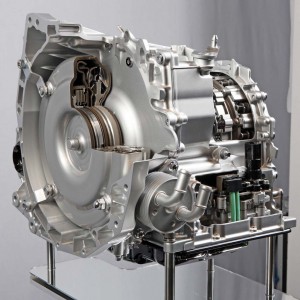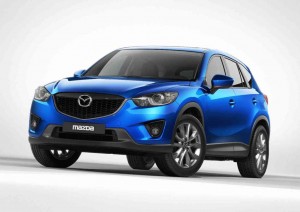
The new Mazda CX-5 crossover will be the maker's first vehicle developed specifically to use the new Skyactiv system, though the Skyactiv powertrain will appear first on the 2012 Mazda3 update.
“We are a very small company,” says Kyoshi Fujiwara – again. It’s a mantra repeated over and over by the Japanese engineer who has become something of the chief cook and bottle washer for Mazda’s ambitious Skyactiv project.
The far-reaching effort could be the make-it-or-break it for, yes, this very small company, which has largely severed its ties with Detroit giant Ford Motor Co. Long known for going its own way with unusual technology – think Wankel rotary engine – Mazda is doing it again with Skyactiv, a system that it claims can deliver the fuel efficiency of a hybrid without the performance and price penalties.
Early next year, Mazda will introduce the new Skyactiv-G gasoline engine on the updated Mazda3 sedan. But the technology isn’t limited to just a new petrol powertrain, ala Ford’s EcoBoost. With Skyactiv, Mazda claims to have re-thought the entire vehicle, coming up with both gasoline and diesel engines, advanced manual and automatic transmissions and lighter-weight platforms that further enhance its drive for improved fuel economy without sacrificing the company’s familiar zoom-zoom qualities.
TheDetroitBureau.com recently got a chance to take an in-depth look at the Skyactiv system and files this report.
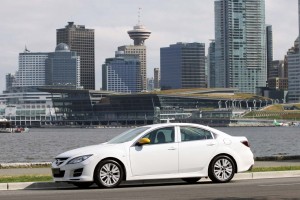
It may look like a Mazda6, but under its cobbled-together skin is the heart of a new Skyactiv vehicle.
Consumers will get their first sense of what’s in store later this year when Mazda launches the updated version of its small Mazda3, which will introduce the Skyactiv-G gasoline engine and the accompanying Skyactiv 6-speed automatic gearbox. The new powertrain is expected to yield the sort of once-contradictory gains automotive engineers long didn’t think possible: torque rising by 15%, to 155 lb-ft, even as fuel economy also jumps 15%, to 40 mpg on the highway. Horsepower, meanwhile, climbs to 165.
Sounds good? Yes, but…
As Fujiwara points out during a Skyactiv background session in Vancouver, the 2012 Mazda3 is basically a halfway measure that doesn’t take advantage of the full combination of technologies that compromise what might be described as the Skyactiv system. The critical missing components will debut next year on the all-new Mazda CX-5 crossover.
(Mazda will unveil the new CX-5 at the upcoming Frankfurt Motor Show. Click Here for that story.)
With the CX-5, Mazda also adapts a new platform design that is light and rigid. Like most of its competitors, Mazda is moving to downsize the line-up of “architectures” used in its line-up, a strategy that will improve economies of scale, something critically important to such a “very small company.”
Nonetheless, that requires some extreme “monotsukuri,” roughly translated into “innovation,” by Fujiwari, so that the SkyActiv platform underneath the CX-5 will be able to flex enough to be used in a wide range of additional vehicles, large, medium and small, crossover and conventional passenger car.
That’s all the more challenging when your goal is to not only meet the latest crash standards – with a targeted 5-star rating – but to do it while also slicing off several 100 pounds of weight.
During the Vancouver event we get the opportunity to drive a prototype platform hidden under a cobbled-together Mazda6 body. Clearly, it required some compromises to make this mule hold together. Nonetheless, chassis chief engineer Hidenou Matsuoka notes that the Skyactive design, with its extensive use of aluminum and other efficiencies, is about 220 pounds lighter than the conventional midsize sedan.
Our first drive takes us behind the wheel of a mule outfitted with the new Skyactiv-D diesel engine – which Mazda plans to bring to the U.S. by early 2013, at the latest – all but certainly positioning it as the first Japanese maker to see a diesel-powered passenger car in the U.S.
The diesel does not require the urea after-treatment system found on most current U.S. diesels, it should be noted, something that will hold down the cost of purchase and the complexity of ownership. The trick is reducing the compression ratio to 14:1, down from the normal diesel 18:1 ratio.
Add multi-stage turbocharging and direct injection using multi-hole piezo-electric injectors, with variable valve timing on the exhaust side. Somewhat similar in concept to Fiat’s award-winning Twin Air system, the Skyactiv-D can deliver up to eight rapid injections of diesel fuel, depending upon load and demand, to maximize each cycle.
Mazda claims this all comes together for a leaner, cleaner burn that is both more fuel efficient and able to better clean up particulates and oxides of nitrogen.
The diesel is expected to deliver about 20% better fuel efficiency than a comparable 2.2-liter package. But what initially impresses, when you stomp the throttle, is its raw power. The Skyactiv-D turns out 173 horsepower at 4,500 RPM, torque peaking at 310 lb-ft at a relatively low 2,000 RPM. What’s impressive is that it can continue spinning up to an official redline of 5,200 revs, well above normal diesel limits.
Coincidentally, the Skyactiv-G gas engine also is optimized for a 14:1 compression ratio – worldwide, that is, though Mazda engineers have decided to reduce that to 13:1 for the U.S. to eliminate the need for premium fuel. A typical gas engine will go with a 9:1 ratio, with the rare, high-performance package nudging 11:1.
The first challenge is preventing destructive engine knock. To get there, Mazda took several steps, including an unusual, cup-like piston head design. Meanwhile, a distinctive 4-to-2-to-1 exhaust manifold reduces the backflow of hot gases, lowering the initial cylinder temperature, a major factor in knock. The Sky-G team adopted a smaller bore, and sequential valve timing, as well as the multi-opening injectors seen on the diesel. There were also steps taken to reduce frictional losses, while overall weight was also addressed, coming down about 20% compared to a traditional engine.
The result? “The Sky-G has achieved diesel levels of fuel economy,” says engineer Rutaro Isobe as we go for our first drive.
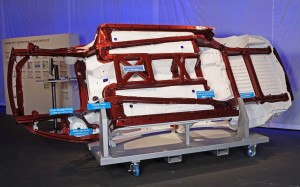
Making intensive use of aluminum and high-strength steel, the Skyactiv platform and body-in-white will be stronger and lighter than older designs.
Like the Skyactiv-D, we immediately notice the peppiness of the gas engine, its higher output made all the better by a lighter chassis and body. Then there’s the Skyactiv transmission. The automatic gearbox proves about as quick as anything we’ve experienced of late. And while it is “only” a 6-speed in a market migrating to 7s, 8s and even 9s, few motorists will likely care. There’s little hunting and seeking and most shifts are essentially transparent.
The manual gearbox, meanwhile, boasts extremely short throws and lives up to the zoom-zoom, sports car-like DNA Mazda aims to build into its products.
Of course, driving a jury-rigged mule isn’t the same as getting behind the wheel of a production Mazda3 or CX-5, but the general refinement of these prototypes suggests we’ll only be more impressed with the final results.
A critical factor will be pricing. Mazda hints it will not demand the sort of premium we’re seeing for some “eco” high-mileage models, and certainly will bring both the gas and diesel versions of Skyactiv in for less than what the competition demands for hybrid technology.
That could give it bragging rights to counter the boasts that competitors like Toyota and Honda make for their gas-electric offerings.
This very small company will need all the help it can get catching the attention of today’s buyers. But Mazda officials are betting they can achieve a significant bump in share once they launch Skyactiv and begin migrating it into the rest of the line-up as various models are updated or replaced.
Incidentally, Fujiwara stresses that Mazda isn’t walking away from hybrids entirely. He admits that as 2025 approaches, with the newly-approved 54.5 mpg CAFE standard, adding some sort of electric assist may be necessary. But then again, maybe not. Mazda is already working on Skyactiv generation-two, he hints, and the possibilities for still further improvements are substantial.

